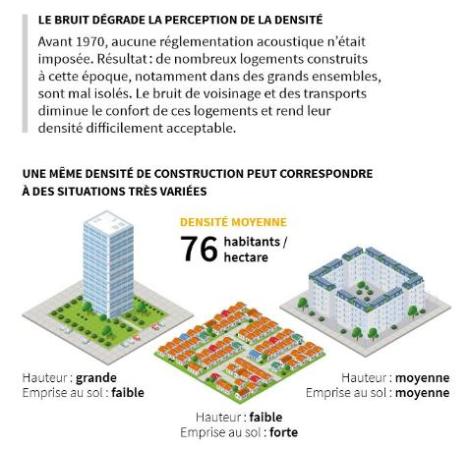How to rethink cities?
Which cities for tomorrow? Controlling urban sprawl and rethinking the city
February 2018
Agence pour l’Environnement et la Maîtrise de l’Energie (ADEME)
Urban sprawl has repercussions on our lives and our environment: reduction of natural and agricultural land, deterioration of biodiversity, increased risk of flooding (because water can no longer penetrate waterproofed soil), difficulty in creating coolness in the city during periods of high heat, significant damage during more frequent natural disasters… Today’s regulations encourage the economical management of space. A multitude of strategies and actions are being taken to make our cities sustainable and pleasant to live in without spreading them further, while contributing to the fight against climate change. How can we curb urban sprawl? How can we make cities sustainable, liveable and accessible to all?
To download : guide-pratique-quelles-villles-pour-demain.pdf (2.4 MiB)
In order to curb urban sprawl, it is essential to make cities more accessible and desirable. These objectives are now on the minds of planners and urban designers who are proposing new ways of living, travelling and working…
Making cities more pleasant to live in
Reconciling the well-being of populations, the preservation of resources and economic development is at the heart of urban planning policies. Development programmes seek to take advantage of the benefits of density (proximity to services, access to public transport, neighbourhood life) and work on quality urban design (acoustics, views, privacy, nature in the city, etc.) to improve the perception of spaces. Living in the city thus becomes more desirable.
Different densities and feelings
Density can be perceived very differently depending on the atmosphere, the architectural quality of a district or a city, the height of the buildings, their layout, the proportion of green spaces, accessibility, etc. In other words, it depends on the « urban forms » and the feelings of each individual.

A great diversity of urban compositions in France
When we talk about « urban forms », we are generally talking about the quality and general organisation of buildings and outdoor spaces (heights, facades, roofs, boundaries between private spaces, collective spaces and public spaces, circulation, etc.). This notion also includes the arrangement of the different spaces of a city in relation to each other. In France, there is a multitude of situations.

Producing, exchanging and consuming energy differently
Urban areas consume almost 80% of the energy in France, mainly to meet the needs of buildings and transport. To limit energy consumption and reduce greenhouse gas emissions by a factor of four by 2050, innovative solutions are being implemented. Transport could undergo a revolution in the next few years thanks to the development of new services such as carpooling, carsharing, fleets of shared electric vehicles and « à la carte » transport, putting an end to the predominance of the private car. Experiments are being conducted to pool and transfer energy from one building to another. We now know how to construct highly efficient buildings that consume very little energy. By installing renewable energies on the roofs or façades, these buildings can even produce more energy than they consume. This available energy can then be transferred to older, less efficient buildings, or fed into the city’s electricity grid and used to charge electric vehicles.
New urban planning rules to meet the needs of the city of tomorrow
For decades, towns, districts, housing estates and plots of land have been governed by town planning rules; the vast majority of municipalities have a PLU (Local Town Planning Scheme) which is revised periodically to take account of changes in the area. All building or development permits are examined in the light of the town planning regulations: building area, height, size, parking, etc. In order to better take into account certain environmental issues (soil preservation, reduction of artificialization), several recent laws have revised the rules concerning buildable spaces and the place of nature in the city. Local authorities must now justify their need to use natural and agricultural areas. They also have to favour building close to means of transport. Vegetation in the heart of cities helps to limit overheating in hot weather:
-
vegetation provides shade,
-
by replacing concrete floors, it prevents heat storage,
-
Finally, the « breathing » of plants releases moisture and thus brings coolness.